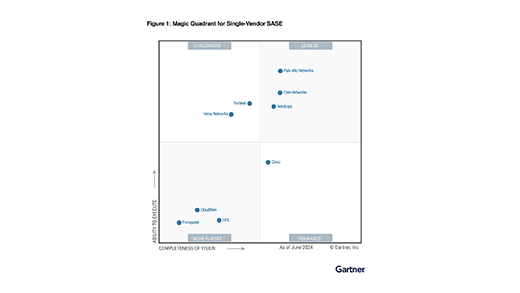Netskope Threat Labs publishes a monthly summary blog post of the top threats we track on the Netskope platform. This post aims to provide strategic, actionable intelligence on active threats against enterprise users worldwide.
Summary
- OneDrive and GitHub were on the top of the list of top cloud apps used for malware downloads, showing a very strong preference from adversaries and the return of GitHub to the top three.
- Attackers continue to attempt to fly under the radar by using cloud apps to deliver malware. In February, 49% of all malware downloads originated from a record-setting 215 distinct cloud apps.
- The top malware families active in February included the banking trojan Grandoreiro, the RAT AdWind, and the ransomware Lockbit.
Cloud Malware Delivery
Attackers attempt to fly under the radar by delivering malicious content via popular cloud apps. Abusing cloud apps for malware delivery enables attackers to evade security controls that rely primarily on domain block lists and URL filtering or don’t inspect cloud traffic. In February 2024, 49% of all HTTP/HTTPS malware downloads originated from popular cloud apps. The percentage of downloads from popular cloud apps has hovered around 50% for the past six months.
The number of apps from which Netskope detected malware downloads increased significantly to a new high of 215 apps.
Attackers achieve the most success in reaching enterprise users when they abuse cloud apps that are already popular in the enterprise. Microsoft OneDrive, the most popular enterprise cloud app, has again held the top spot for the most cloud malware downloads, which it has held for more than six months.
Generally, the top 10 apps remained largely unchanged compared to the apps used in the last six months of 2023. GitHub, while consistently appearing in the top 10, returned to the top three for the first time since November. Post-exploitation tools such as SharpRound, PEASS, Mimikatz, and Lazagne are frequently downloaded directly from GitHub. Attackers use various techniques to download malware from GitHub, including making GET requests for the raw files and using the GitHub API.
The top 10 list reflects attacker tactics, user behavior, and company policy.
Top Malware Families
Attackers constantly create new malware families and variants of existing families to bypass security solutions or update their malware’s capabilities. In February 2024, 62% of all malware downloads detected by Netskope were either new families or new variants that had not been observed in the preceding six months. The other 38% were samples previously observed during the preceding six months and are still circulating in the wild.
The following list contains the top malware and ransomware families blocked by Netskope in February 2024:
- Backdoor.Zusy (a.k.a. TinyBanker) is a banking Trojan based on Zeus’s source code, aiming to steal personal information via code injection into websites. Details
- Downloader.BanLoad is a Java-based downloader widely used to deliver a variety of malware payloads, especially banking Trojans. Details
- Infostealer.Lazagne is a password recovery tool that can be used as a hacking tool to steal passwords from infected devices. Details
- Infostealer.RedLine is designed to steal data such as credit card numbers, passwords, VPN and FTP credentials, gaming accounts, and even data from crypto wallets. Details
- Phishing.PhishingX is a malicious PDF file used in a phishing campaign to redirect victims to a phishing page.
- Ransomware.LockBit 3.0 (a.k.a. Black) is the latest version of the LockBit ransomware, which emerged in September 2019, becoming one of the most relevant RaaS groups in the world. Details
- RAT.AdWind is a RAT that can perform actions such as logging keystrokes, collecting sensitive information, downloading and running other payloads, and more. Details
- Trojan.Razy is a Trojan typically distributed via malicious ads disguised as legitimate software, often used to steal cryptocurrency data. Details
- Trojan.Valyria (a.k.a. POWERSTATS) is a family of malicious Microsoft Office Documents that contain embedded malicious VBScripts, usually to deliver other malicious payloads. Details
- Trojan.Grandoreiro is a LATAM banking trojan with the goal of stealing sensitive banking information, commonly targeting Brazil, Mexico, Spain, and Peru. Details
Recommendations
Attackers have always sought to evade detection and avoid suspicion in delivering malware. Attackers have been increasingly using two strategies in the past six months: delivering malware by abusing cloud apps and packaging malware in PDF files. Netskope Threat Labs recommends that you review your security posture to ensure that you are adequately protected against both of these trends:
- Inspect all HTTP and HTTPS downloads, including all web and cloud traffic, to prevent malware from infiltrating your network. Netskope customers can configure their Netskope NG-SWG with a Threat Protection policy that applies to downloads from all categories and applies to all file types.
- Ensure that your security controls recursively inspect the content of popular archive files, such as ZIP files, for malicious content. Netskope Advanced Threat Protection recursively inspects the contents of archives, including ISO, TAR, RAR, 7Z, and ZIP.
- Ensure that high-risk file types like executables and archives are inspected using both static and dynamic analysis before being downloaded. Netskope Advanced Threat Protection customers can use a Patient Zero Prevention Policy to hold downloads until they have been fully inspected.
- Configure policies to block downloads from apps that are not used in your organization to reduce your risk surface to only those apps and instances that are necessary for the business.
- Block downloads of all risky file types from newly registered domains and newly observed domains.
In addition to the recommendations above, Remote Browser Isolation (RBI) technology can provide additional protection when there is a need to visit websites that fall into categories that present higher risk, such as Newly Observed and Newly Registered Domains.
About This Report
Netskope provides threat and data protection to millions of users worldwide. Information presented in this report is based on anonymized usage data collected by the Netskope Security Cloud platform relating to a subset of Netskope customers with prior authorization. This report contains information about detections raised by Netskope’s Next Generation Secure Web Gateway (SWG), not considering the significance of the impact of each threat. Stats in this report are based on the period starting July 1, 2023 through February 29, 2024. Stats reflect attacker tactics, user behavior, and organization policy.




 Back
Back 
















 ブログを読む
ブログを読む